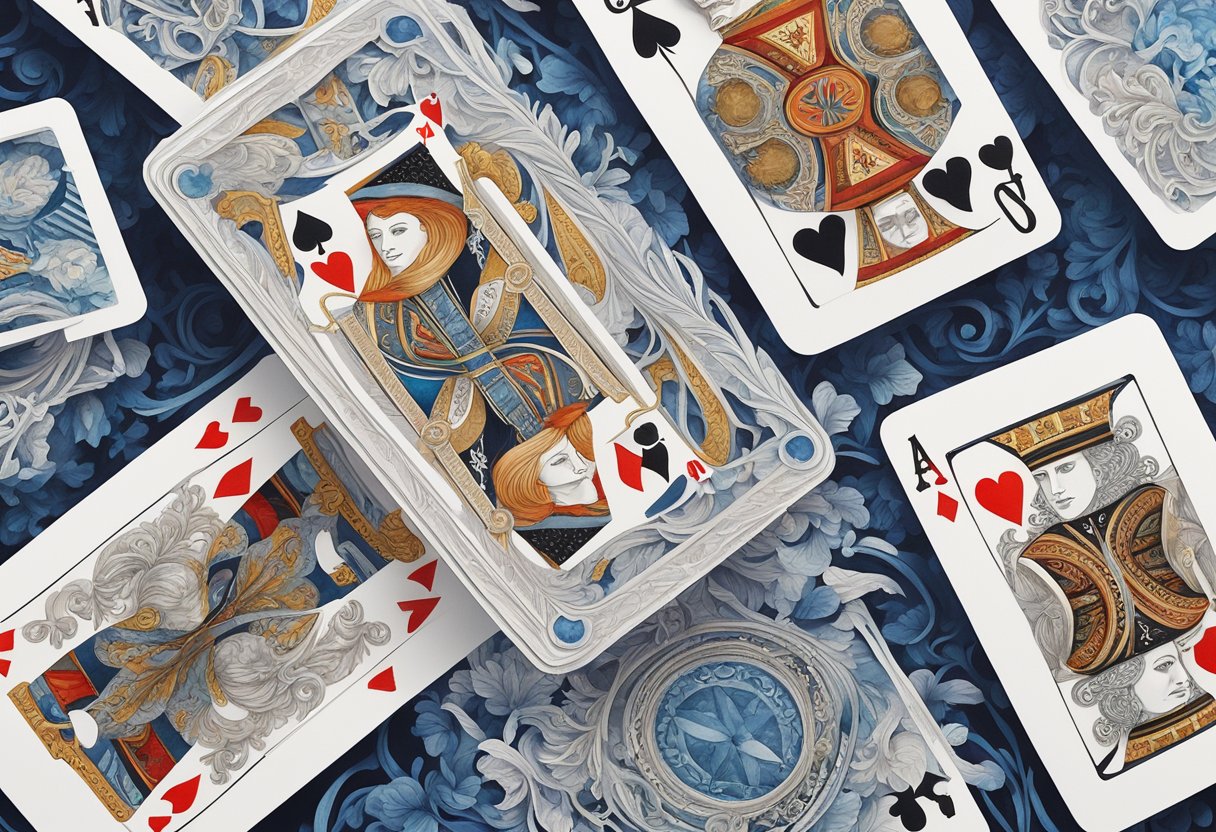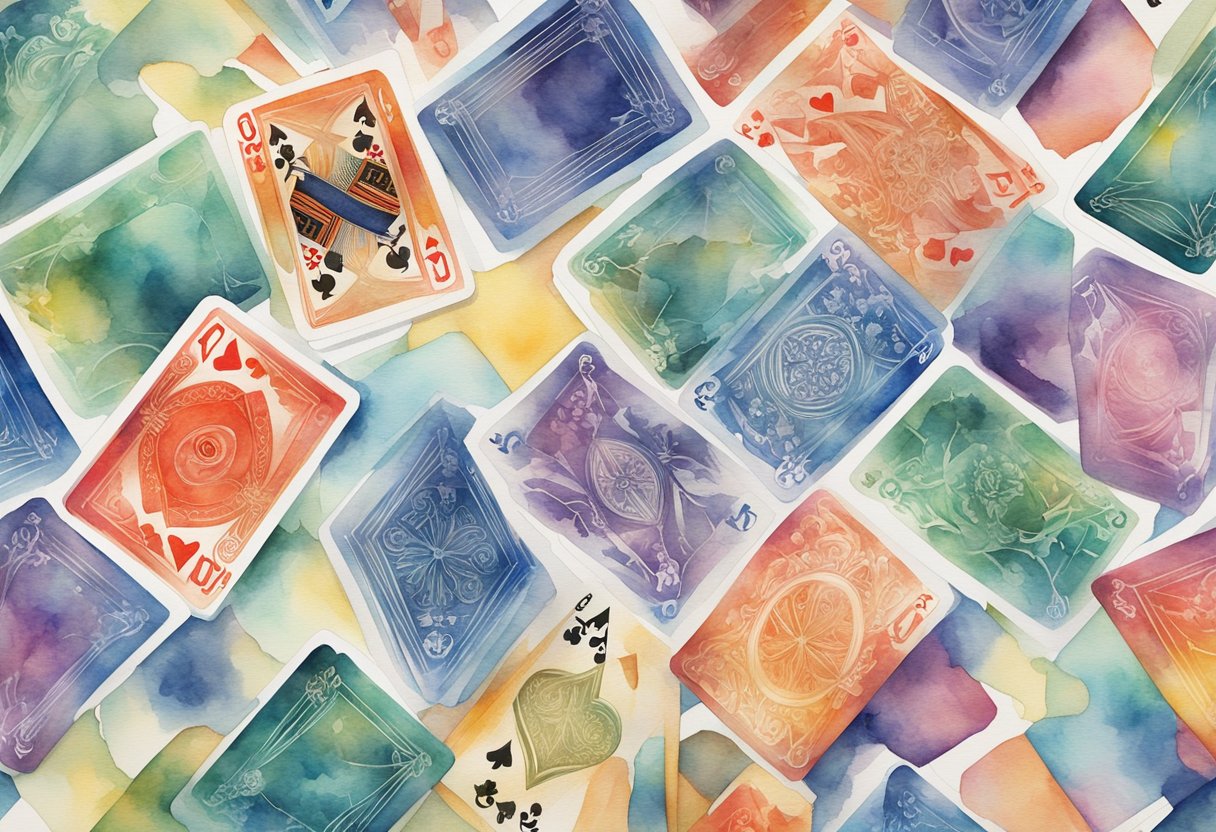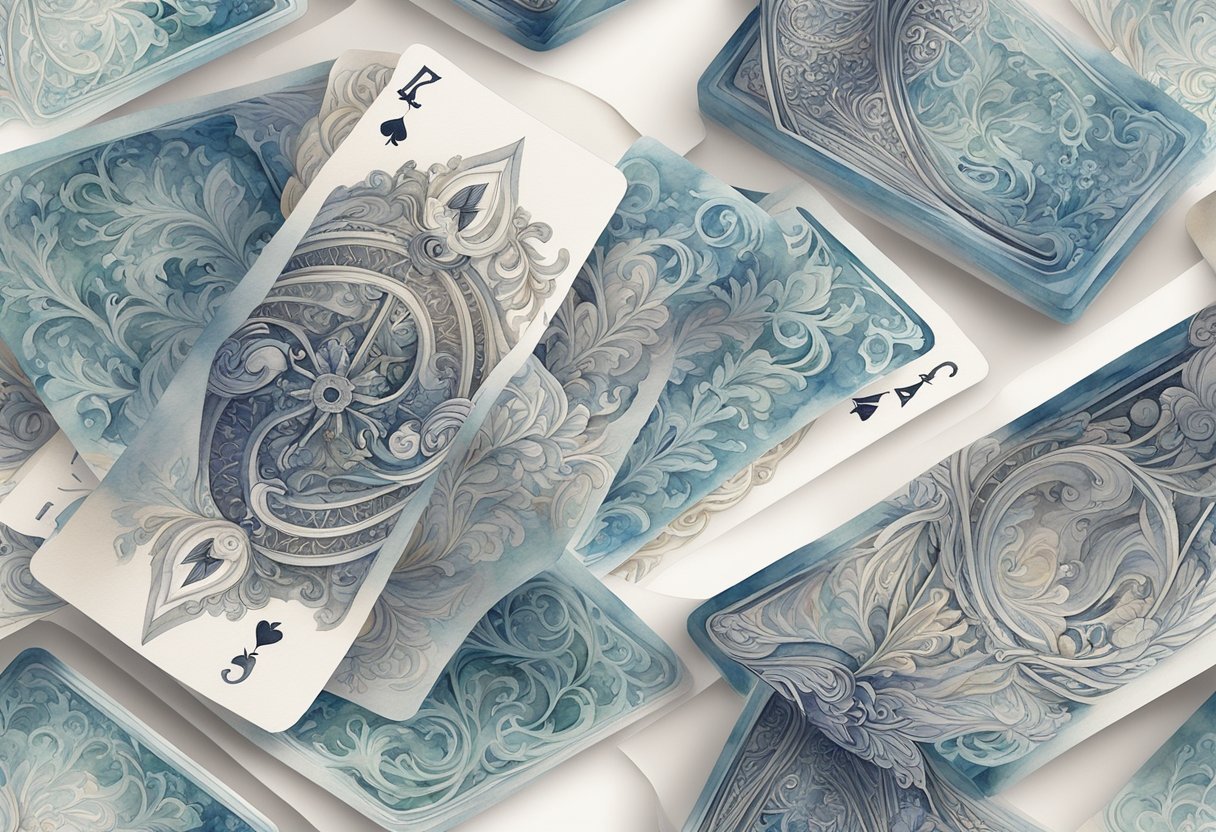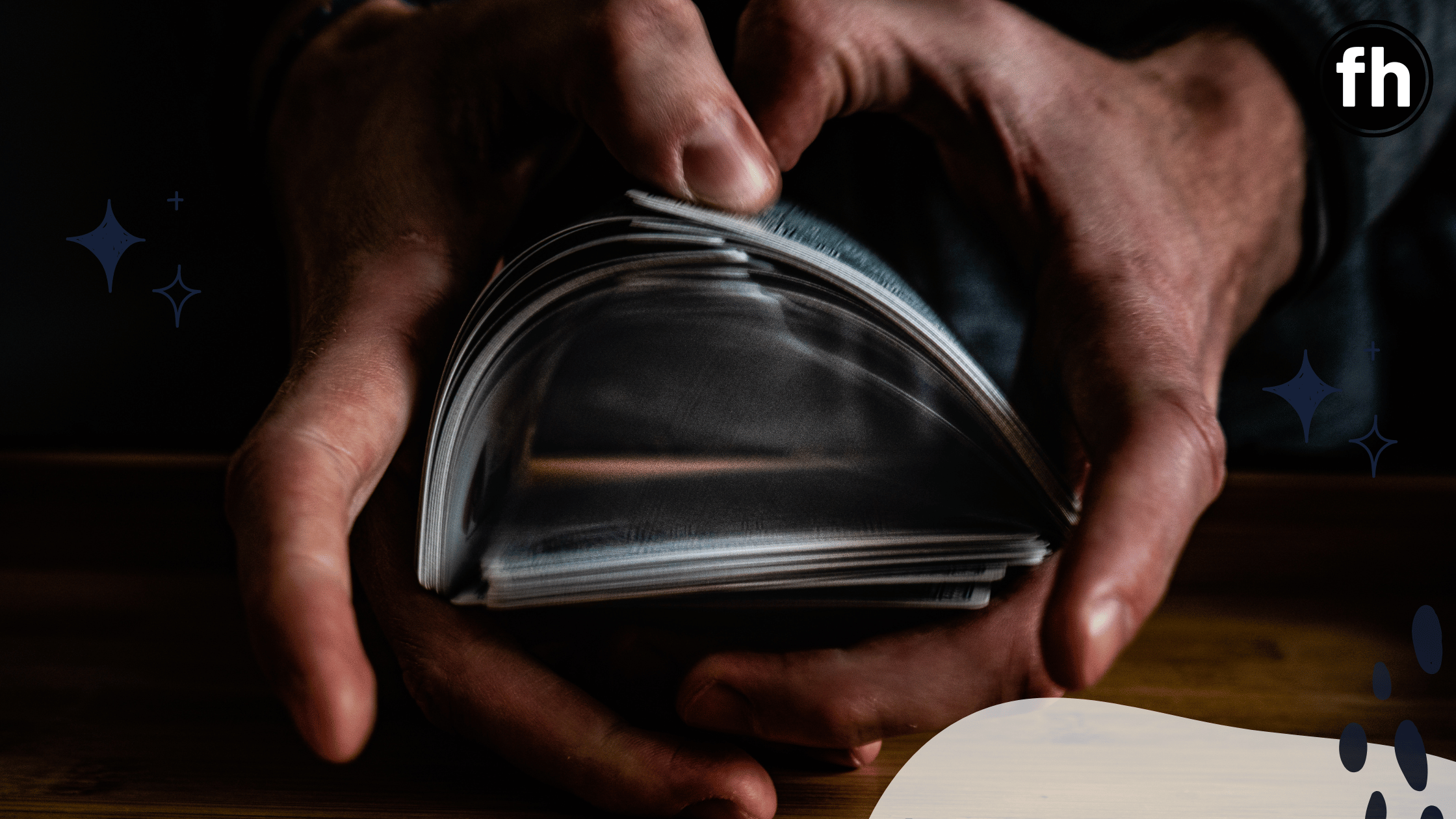Beginner’s Guide to Cardistry: Mastering the Art of Card Flourishing
Cardistry is the art of card flourishing, a performance craft where you bring a deck of playing cards to life through intricate cuts, shuffles, twirls, and movements that are visually stunning.
As a beginner, you may find this blend of skill, precision, and creativity both intriguing and intimidating. But with dedication and practice, you can learn to manipulate cards in a way that is not only entertaining but also a creative expression of your personality.

Your journey into cardistry will start with mastering fundamental techniques. These basics form the building blocks for more complex and elaborate flourishes.
As you progress, you’ll develop a deeper understanding of the mechanics behind each movement. The beauty of cardistry lies in its infinite possibilities; there are always new moves to discover, patterns to create, and styles to develop.

Diving into the world of cardistry can be exciting and rewarding. As a beginner, the quality of your playing cards and the mastery of fundamental grips are essential to developing your skill.
Choosing Your First Deck
When selecting your first deck of playing cards, consider opting for poker-sized playing cards, which are the standard size for cardistry due to their playability and handling.
The Bicycle playing cards are a reliable choice, known for their durability and affordable price, making them ideal for practice.
Alternatively, Tally-Ho playing cards are favored for their smooth finish and stiffer stock.
For those who prefer a more premium feel, Copag playing cards offer a unique, higher-end experience with their long-lasting and distinct design.
- Cost-Effective: Bicycle playing cards
- Smooth Handling: Tally-Ho playing cards
- Premium Option: Copag playing cards
Your chosen deck should promote a comfortable learning experience. Ensure that your hands are clean and dry when handling the cards to maintain their condition.
Fundamental Grips and Positions
To set the stage for advanced techniques, mastering the fundamental grips and positions is a must.
Begin with the dealer’s grip, which provides stability and control, laying the groundwork for more complex flourishes.
Basic Grips:
- Dealer’s Grip: Hold the deck in your non-dominant hand with your thumb along one long edge, your index finger at the front edge, and your remaining fingers on the other long edge.
- Biddle Grip: Used for a variety of cuts and shuffles, this grip involves holding the deck between your thumb at one corner and your middle and ring fingers at the opposite corner.
Maintaining a gentle touch is key; you want to avoid bending the cards excessively while ensuring smooth motions. Frequent practice using these grips will enhance your dexterity and prepare you for more intricate cardistry moves.
Basic Techniques and Cuts

In the art of cardistry, mastering fundamental techniques and cuts is essential for developing your skills. These foundational moves lay the groundwork for more complex flourishes and ensure you handle the cards with precision and efficiency.
The Charlier Cut
The Charlier Cut is one of the most fundamental single-handed cuts you should learn. It requires you to hold the deck in one hand and execute a cut using a pivot point on your thumb.
This cut not only builds your dexterity but also familiarizes you with the balance and handling of the cards. Here’s a step-by-step overview:
- Hold the deck in a mechanic’s grip.
- Use your thumb to split the deck into two.
- Pivot the lower half of the deck to complete the cut.
The Charlier Cut is a staple in cardistry and a starting point for many other complex moves.
The Thumb Fan
Creating a Thumb Fan involves spreading the cards out in a circular fashion using mainly your thumb. This technique is pivotal in displaying the aesthetics of a card deck and improving hand flexibility. To execute a thumb fan, follow these instructions:
- Place the deck in your left hand using a mechanic’s grip.
- Use your right thumb to evenly spread the cards out.
- Practice the motion to ensure the fan is even.
For a visually stunning fan, your pressure and the evenness of the spread are crucial. If you’re interested in the details of this technique, you can explore more about the Thumb Fan.
The Spring
The Spring is a dynamic move that creates a cascade of cards from one hand to another, showcasing both control and elasticity of a deck. This flourish requires a certain level of tension and pressure to be applied. The steps include:
- Hold the deck in a biddle grip.
- Apply pressure with your fingers to bend the cards.
- Release the cards in a controlled manner to spring into the opposite hand.
The sound and visual effect of the Spring is immediately satisfying and is one of the cornerstones of cardistry moves. To properly learn this technique, you might want to check out resources specifically focusing on the Spring flourish.
Intermediate Flourishes and Tricks

As you progress in cardistry, you’ll encounter techniques that demand more dexterity and offer visual complexity. The intermediate flourishes and tricks not only refine your skill but also begin to define your style as a cardist.
The Sybil Cut
The Sybil Cut is a fundamental flourish that serves as the backbone for numerous complex cardistry routines. It’s a multi-packet cut where you separate the deck into several packets and weave them together in a smooth, flowing motion.
Ensure that your thumb and fingers are well positioned to maintain control of the cards during each pivot and turn.
The Werm
Moving to a slightly more dynamic flourish, The Werm is a continuous sequence where a small packet of cards is twisted and flipped over the deck. This trick incorporates a twisting action of your wrist, requiring careful balance and coordination. Sharp, snappy motions will make your Werm flourish look especially captivating.
Card Twirls and Spins
Adding a flair of drama, card twirls and spins are about making a single card or a packet dance between your fingers.
To execute these effectively, you need to finesse the card’s pivot point, often using your thumb as the axis. This is where your control and precision play a pivotal role, as you’ll need to maintain momentum while keeping the card in motion without dropping it.
Developing Fluidity and Style

In cardistry, the seamless flow of movements and a unique style differentiate novices from experts. Mastery over fluidity and an individual’s flair comes from understanding and combining moves and building cohesive routines.
Combining Moves
To create a visually stunning performance, you need to smoothly transition from one move to the next.
Focus on the precision of each gesture and how it fluidly connects to the next. Start with simple patterns and sequences like card spreads and cuts.
As you progress, intertwine more complex flourishes to elevate the visual aesthetics. Below is a simple table to guide you through the process:
| Start With | Progress To | Aim For |
|---|---|---|
| Basic Grips | Card Spreads | Seamless Transitions |
| Simple Cuts | Complex Cuts | Graceful Motions |
| Basic Fans | Intricate Fans | Synchronized Patterns |
Creating Routines
Crafting a routine incorporates both creativity and style. Think of each routine as a story with a beginning, middle, and an end.
Start by selecting a few moves that fit well together, and practice the transitions until they’re second nature.
Remember, each routine should reflect your personal twist and serve as an expression of your own performance art.
- Start Simple: Choose 3-4 moves that you can perform confidently.
- Build the Structure: Develop a sequence that allows the moves to flow together logically.
- Inject Personality: Introduce elements that showcase your style and creativity.
- Practise for Fluidity: Drill your routine to ensure each motion is executed with fluid precision.
Advanced Handling and Dynamics

In cardistry, your progression to advanced techniques will vastly enhance the visual impact and the precision of your performances. You’ll be challenged to refine your handling, coordination, and deck manipulation, pushing your dexterity to new heights on a soft surface that facilitates smooth operations.
The Hot Shot Cut
The Hot Shot Cut is not only a staple in cardistry but also a test of your adeptness.
To perform it, you must hold your deck in a certain grip that allows a single card to be shot out from the deck, pivoting into your other hand. This requires a keen sense of timing and coordination, pairing swift movements with graceful control.
As you practice, you’ll find that the right deck and a supple handling technique are crucial for a clean shot.
The Faro Shuffle
Considered a testament to a cardist’s skill development, the Faro Shuffle intertwines the cards from each half of the deck perfectly.
Start by splitting the deck into two equal halves and then gently weave them together, card by card, ensuring a consistent and seamless shuffle.
A soft surface can aid in the initial alignment of the two deck halves, easing the shuffle.
Mastery of the Faro Shuffle speaks volumes about a cardist’s precision and their ability to manipulate the deck dynamics to their whim.
The Revolution Cut
Moving on to the Revolution Cut—a flourish that epitomizes the blend of spins and pivots—this maneuver involves splitting the deck and then skillfully rotating one half 360 degrees around the other before reassembling the deck into one stack.
It’s a move that’s manipulated almost entirely with a single hand, demanding a high level of skill and hand strength.
Coordination between your fingers ensures the cut is fluid, displaying a harmonious motion that can mesmerize observers.
With each cut and shuffle, you’re not just moving cards; you’re creating an art form that’s perpetually evolving.
Through continuous practice of these advanced techniques, your fluency in the language of cardistry will grow, allowing you to express yourself with a deck in ways you never thought possible.
Building Your Cardistry Community

When you start practicing cardistry, connecting with a community can greatly enhance your learning experience.
You’ll find inspiration, support, and the collective wisdom of fellow enthusiasts.
Social Media and Sharing
Your cardistry journey doesn’t have to be solitary; social media platforms are excellent places to share your progress and discover new techniques.
Instagram and YouTube are particularly vibrant hubs where cardists showcase their skills.
On Instagram, you can follow influential cardists like Dan and Dave Buck or Zach Mueller, who often post tutorials and inspiring performances.
YouTube is a gold mine for comprehensive online tutorials by experts such as Andrei Jikh and others, helping you master everything from the basics to the most intricate flourishes.
Joining Forums and Groups
Forums and groups specifically dedicated to cardistry offer a more focused venue for discussion and advice.
Join cardistry forums like the subreddit /r/cardistry, where you can engage with a global community ready to share tips and tutorials.
Here, you can also find a curated list of moves to learn, from beginner to advanced levels.
Additionally, look for groups on platforms like Facebook or websites like ambitiouswithcards.com or hobbyfaqs.com where cardistry enthusiasts gather to discuss the hobby, share resources, and organize meetups, both virtual and in-person.
Care and Maintenance of Playing Cards

Proper care for your deck of playing cards is essential to maintaining their vibrant colors and performance, especially if they feature an air-cushion or embossed air-cushion finish. Here’s how you can ensure your cards remain in top condition.
Handling Your Cards:
- Clean and Dry Hands: Always handle your cards with clean and dry hands to prevent oils and dirt from damaging the finish.
Storing Your Cards:
- Ideal Conditions: Store your deck in a cool, dry place away from direct sunlight to protect the stock and finish.
- Card Case: Use the original card case or a card clip to help maintain the deck’s shape.
Usage Tips:
- Shuffle with Care: Be gentle to retain the finish and prevent bending.
- Rotate Decks: Avoid overusing a single deck to distribute wear evenly.
Cleaning:
- Light Dirt: Wipe your cards with a soft, dry cloth for superficial dirt.
- Sticky Residues: For tougher grime, lightly dampen a cloth with water and gently wipe the cards, then thoroughly dry them.
| Do’s | Don’ts |
|---|---|
| Use a light touch | Bend or fold the cards |
| Regularly rotate decks | Expose to moisture or heat |
| Keep the deck encased | Apply harsh cleaning agents |
Expanding Your Horizons

As you delve deeper into cardistry, enriching your experience is key.
You’ll want to explore the interconnectedness of card magic and the joys of collecting decks as souvenirs of your progress.
Exploring Card Magic
Cardistry often serves as a gateway to the wider world of card magic.
By integrating sleight of hand and illusions into your repertoire, you can develop a unique style that distinguishes your performances.
Emphasizing creativity and skill, card magic requires both poker-sized and bridge-sized decks, with standard Bicycle playing cards often recommended for their availability and quality.
- Start with Basics: Learn fundamental tricks to build a strong foundation.
- Practice Regularly: Consistent practice sharpens your finesse and timing.
Collecting and Souvenirs
Every deck of cards carries a story, and many practitioners of cardistry find passion in collecting unique or limited edition decks.
Souvenir decks can commemorate milestones in your journey, or represent different styles and cultures you encounter.
While knock-off budget decks can be tempting, investing in higher quality cards like standard Bicycle playing cards ensures durability and a more satisfying handling experience.
- Quality Over Quantity: Prioritize acquiring decks known for their craftsmanship.
- Display Your Collection: Showcase decks as part of your personal cardistry story.
Frequently Asked Questions

Embarking on the journey of cardistry can raise many questions. Here you’ll find answers to some common queries to help you start with confidence.
What are the basic moves that every cardistry beginner should learn?
You should aim to master foundational moves like the Charlier Cut, the Scissor Cut, and the Fan. These form the basis for more complex flourishes and help develop dexterity.
What type of playing cards are best for a cardistry beginner?
Start with a deck that has good handling, like Bicycle or Tally-Ho cards. They are durable and affordable, which is perfect for practicing often.
How much time does it typically take to become proficient in cardistry?
Proficiency varies by individual, but with dedicated practice, you can see significant improvement in a few months.
Where can I find cardistry learning resources for a complete beginner?
There are free tutorials available on platforms like YouTube, and websites like Fontaine Cards provide detailed guides to help you begin your journey in cardistry.
Can cardistry be self-taught, and if so, where should one start?
Yes, cardistry can be self-taught. Start with simple moves and gradually work up to more complex sequences by utilizing online tutorials.
What are some affordable yet high-quality playing cards for practicing cardistry?
Look for decks designed with cardistry in mind such as those by Fontaine Cards or Theory11.
These decks balance quality and cost, making them suitable for beginners.

